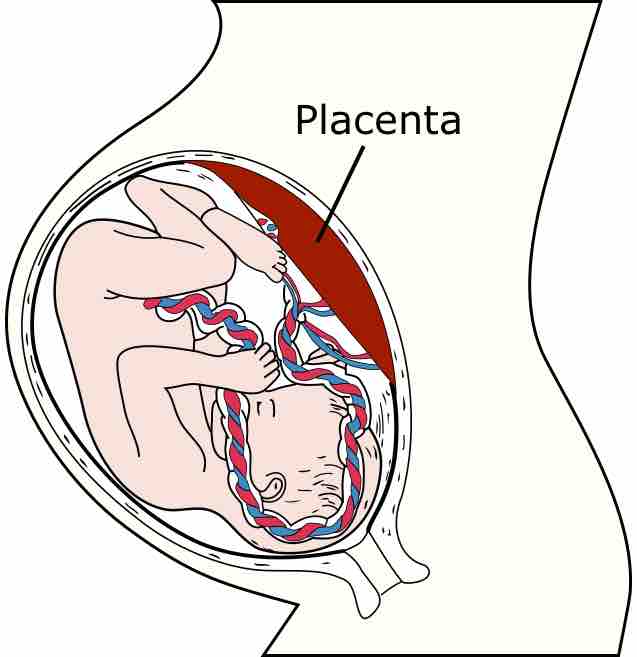The placenta is an organ connecting the developing fetus to the uterine wall to allow nutrient uptake, waste elimination, and gas exchange via the mother's blood supply.
The placenta functions as a feto-maternal organ with two components:
- The fetal placenta, which develops from the same sperm and egg cells that form the fetus.
- The maternal placenta, which develops from the maternal uterine tissue.
In humans, the placenta averages 22 cm in length and 2–2.5 cm in thickness; it typically weights 500g and is a dark-reddish color due to the large quantities of blood contained within.
The placenta connects to the fetus by an umbilical cord of approximately 55–60 cm in length that contains two arteries and one vein. Unlike the majority of systemic vessels the arteries in the umbilical cord carry de-oxygenated blood and the vein carries oxygenated blood.

Placenta
The placenta is an organ connecting the developing fetus to the uterine wall to allow nutrient uptake, waste elimination, and gas exchange via the mother's blood supply.
The umbilical cord inserts into the chorionic plate of the placenta. Vessels branch out over the surface of the placenta and further divide to form a network covered by a thin layer of cells. This results in the formation of villous tree structures that allow for the efficient exchange of gasses and nutrients.
Functions of the Placenta
The major functions of the placenta include:
The perfusion of the intervillous spaces of the placenta with maternal blood allows the transfer of nutrients and oxygen from the mother to the fetus and the transfer of waste products and carbon dioxide back from the fetus to the maternal blood supply.
Waste products excreted from the fetus—urea, uric acid, and creatinine—are transferred to the maternal blood by diffusion across the placenta.
IgG antibodies can pass through the human placenta, thereby providing protection to the fetus in utero. The placenta functions as a selective maternal–fetal barrier against the transmission of microbes to the fetus. However, deficiency in this function may cause mother-to-child transmission of infectious diseases.
Endocrine Functions
The placenta also secretes hormones that are important during pregnancy. These hormones include:
- Human chorionic gonadotropin
- Human placental lactogen
- Estrogen
- Progesterone
Human chorionic gonadotropin (hCG) is the first placental hormone produced, which can be found in maternal blood and urine as early as the first missed menstrual period (shortly after implantation has occurred) through about the hundredth day of pregnancy.
This is the hormone analyzed by a pregnancy test; a false-negative result from a pregnancy test may be obtained before or after this period. Women's blood serum will be completely negative for hCG by one to two weeks after birth. hCG testing is proof that all placental tissue is delivered. hCG is present only during pregnancy because it is secreted by the placenta, which is present only during pregnancy.
hCG also ensures that the corpus luteum continues to secrete progesterone and estrogen. Progesterone is very important during pregnancy because, when its secretion decreases, the endometrial lining will slough off and pregnancy will be lost. hCG suppresses the maternal immunologic response so the placenta is not rejected.
Human placental lactogen is lactogenic and promotes mammary gland growth in preparation for lactation in the mother. It also regulates maternal glucose, protein, and fat levels so they are always available to the fetus.
Estrogen stimulates the development of secondary female sex characteristics. It contributes to the woman's mammary gland development in preparation for lactation and stimulates uterine growth to accommodate the growing fetus.
Progesterone is necessary to maintain the endometrial lining of the uterus during pregnancy. This hormone prevents pre-term labor by reducing myometrial contractions. Levels of progesterone are high during pregnancy.